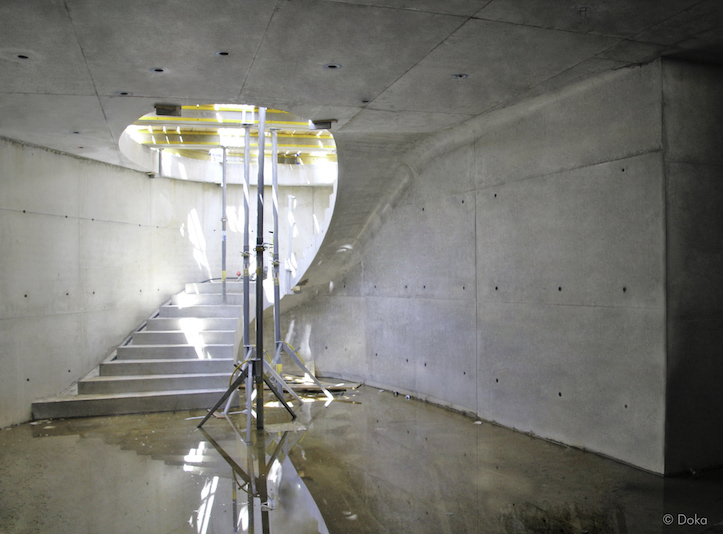A first-class reference: DOKA uses voxeljet for the construction of complex formworks
During the construction of the headquarters of the Sächsische Aufbaubank in Leipzig, a semi-spiral staircase with intermediate landing was to be erected, which is mounted on a supporting wall. In order to give it a gentle and even curve, a highly precise concrete formwork was required.
The responsible parties relied on Doka, the world-renowned formwork supplier. After extensive analysis and definition of the formwork shape for the staircase, the surfaces were categorised according to their complexity. Uniaxially curved surfaces with cylindrical or conical shapes were formed conventionally. The special feature of this staircase, however, was the triaxially curved surface that reproduced the fillet of the staircase soffit to the inside of the load-bearing wall.
The production of such forms in conventional craftsmanship is extremely time-consuming. Wooden strips have to be cut, bent into shape, fixed and glued. Then the surface has to be filled and sanded several times before it is varnished twice. The result is a moulded body whose load-bearing components have been installed under tension and are made of organic material. Under the influence of the temperature and humidity fluctuations present on the building site, as well as the general weather, cracking can easily occur, which visibly impairs the quality.
This is where voxeljet's binder jetting 3D printing offers considerable advantages. Components can be produced more quickly and with less planning effort directly from 3D data. The 3D-printed components are manufactured precisely and stress-free and are therefore very dimensionally stable. The homogeneous material composition offers additional quality assurance in view of the weathering influences mentioned above.
Using the powder-binder jetting process, voxeljet created seven formwork skin parts from sand with a wall thickness of only 21 mm. The manufacturer then infiltrated the elements with epoxy resin to achieve the necessary strength. After painting and sanding, the voxeljet formwork could be used.
This proved to be ideal in two ways: Firstly, only about one tenth of the usual assembly time was required. Secondly, the 3D-printed shells fitted one hundred percent with the CNC-cut Xlife panels from Doka when the form elements were assembled. This hybrid approach ensures the cost-effectiveness of the formwork solution with 3D-printed components. Thirdly, the high precision of the production, based on the continuous digital data processing of the 3D-printed geometries from design to assembly, was impressive. After successful concreting and demoulding, the casting results of the staircase could be compared.
An important aspect: the three-dimensionally curved voxeljet elements were designed in such a way that they could be excellently combined with Doka standard formwork. For example, the Doka staff already placed functional integrations such as drill holes and plug-in connections in the data set. This made it possible to assemble the Doka formwork quickly and efficiently. Erecting the formwork on the site was very fast and efficient thanks to the high precision. Another advantage of the post-treated epoxy-sand mixture is its resistance to weathering and scratching. The use of the voxeljet formwork paid off in more ways than one.
The part of the staircase that was reproduced with voxeljet formwork showed a very good casting result in accordance with the quality of the 3D-printed elements. Neither bleeding nor concrete nests could be found. In retrospect, the Doka employees say that it might even have made sense to realise more surface area for the project via 3D printing. They are confident that the voxeljet formwork can also be used on exposed concrete construction sites.
www.voxeljet.com

 Deutsch (Germany)
Deutsch (Germany)  Polski (PL)
Polski (PL) 









